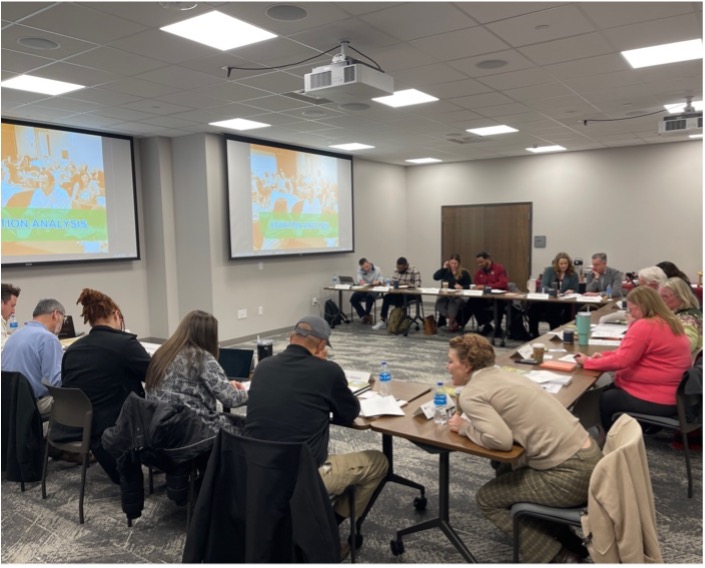Leadership development training days aren’t optional; They are essential for great teams.
Engaging and effective leadership development days are a critical necessity for sustaining your organizational success and growing your people.
Staff training programs play a pivotal role in nurturing the next crop of leaders, equipping them with the skills and knowledge needed to navigate challenges and drive growth. In fact, in 2019 Training Industry reported that “businesses saw an ROI of 29% within only three months of leadership development training and an annual ROI of 415%.
Effective leadership training days can deliver a return on investment of $4 for every $1 spent!

However, merely conducting a training day is not enough. To truly harness its potential, leaders mustensure that these sessions are memorable and impactful, fostering meaningful learning experiences that translate into tangible results for the team and the organization.
To truly unlock the potential impact of your next leadership development day or team retreat, follow these five key steps and transform your program into a catalyst for growth:
-
Focus on Specific Team Needs: Make Learning Personal
(Don’t plan without data, surveys and feedback to determine needed skills)
Start by acknowledging the elephant in the room: generic training often falls flat. Don’t waste your time (and resources) on one-size-fits-all content. Instead, make learning personal.
Action Tip: Gather data, not dust. Conduct surveys, assessments, or hold focus groups to identify your team’s specific needs and development areas. What are their current challenges? What skills do they aspire to build?
Why it Matters: According to a Skillademia article, SHRM reported that 35% of HR managers say a significant challenge lies in obtaining the proper training content tailored to specific requirements for organizations.” Organizations that tailor leadership development programs to specific business challenges see a significant improvement in business performance.
-
Frame with Purpose: Set the Stage for Success
(Don’t allow the event take-aways end up in drawer of forgotten odds and ends)
Training without a clear direction is like setting sail without a map. It leads to aimless wandering and minimal impact. Avoid the “dust-gathering content” pitfall by defining a clear purpose for your training day.
Action Tip: Communicate the “why” before the “what.” Clearly define the training day’s objective and share it with participants beforehand. What do you hope they gain by the end? How will this learning benefit them individually and contribute to the organization’s goals?
Why it Matters: Research in a recent Inc Magazine article shared that “73 percent of employees who say they work at a “purpose-driven” company are engaged, compared to just 23 percent of those who don’t.” When they see the bigger picture, they’re more invested in their own learning journey.
-
Fuel with Interactions: Light a Fire for Engagement
(Don’t let people be passive receptacles – make them active participants)

Ditch the one-way lectures! Learning shouldn’t be a passive experience. Fuel engagement with interactive activities and discussions. Encourage participants to share their experiences, insights, and challenges.
Action Tip: Make it a conversation, not a monologue. Use group discussions, brainstorming sessions, and role-playing exercises to foster collaboration and active participation. Give everyone a voice and create a safe space for open dialogue.
Why it Matters: Studies show that interactive learning methods like group discussions and role-playing can increase retention rates significantly. Entrepreneur magazine reports that “the retention rate from experiential learning can be as much as 90 percent.
There is power in experiential learning because it can change behavior, engage staff and impact organizations for the long-term.” When participants actively contribute to their learning, they’re more likely to retain and apply new knowledge.
-
Fortify with Practice: Hone Skills for Real-World Impact
(Don’t forget that muscle learns by movement, not by lectures or note taking)
Leadership isn’t just about theory; it’s about putting knowledge into action. Incorporate opportunities for participants to practice their skills. This could involve simulations, case studies, or real-world scenarios.
Action Tip: Provide a safe space for experimentation. Create exercises where participants can apply their learning without fear of failure. Offer constructive feedback and encourage them to learn from their experiences.
Why it Matters: Research by Hermann Ebbinghaus shared in Harvard Business Review suggests that “if new information isn’t applied, we’ll forget about 75% of it after just six days.” By providing opportunities for practice and feedback, you equip your leaders with the confidence and skills they need to succeed in real-world situations.
-
Follow up with Evaluation: Measure What Matters
(Don’t move on without gathering insights on immediate and lasting impact)
The learning doesn’t stop when the training day ends. To measure the effectiveness of your program, conduct thorough evaluations.
Action Tip: Seek feedback throughout the journey. Gather feedback from participants both during and after the training to gauge their reactions and identify areas for improvement. Additionally, track long-term metrics like performance reviews and team productivity to assess the program’s lasting impact.
Why it Matters: According to a McKinsey study, “only 11 percent of more than 500 executives we polled around the globe strongly agreed with the statement that their leadership-development interventions achieve and sustain the desired results”

Those 5 steps are the key to elevating your leadership training initiatives from mundane events to transformative experiences.
Don’t allow your next leadership training day to be just another box-checking exercise…
Instead, ensure that it’s an entertaining and valuable investment that ignites your team’s potential and drives tangible results for your organization.
By focusing on team needs, framing with purpose, fueling with interactions, fortifying with practice, and following up with evaluation, you can ensure that your training days are not only engaging but also effective in transforming your people and improving the productivity of your organization.
For personalized guidance and dynamic facilitation that makes professional development events truly impactful, contact Sean Glaze—an experienced and interactive team building speaker dedicated to making your next training day a memorable success.
– – – – –
Sean Glaze is a leadership speaker, teambuilding facilitator, and author who delivers engaging experiences that ignite your team’s performance. Sean has worked with clients like Cisco, John Deere, the CDC, and Emory University to increase collaboration, boost productivity, and build more positive and profitable workplace cultures.
experiences that ignite your team’s performance. Sean has worked with clients like Cisco, John Deere, the CDC, and Emory University to increase collaboration, boost productivity, and build more positive and profitable workplace cultures.
As a successful basketball coach, Sean gained valuable insights on turning talent into teamwork – and now he travels around the country to share those lessons. Sean’s conference keynotes and custom team building events deliver laugh-out-loud moments and memorable take-aways that transform your people into winning teammates and more effective leaders.
Sean’s books, Rapid Teamwork, The 10 Commandments of Winning Teammates, and Staying Coachable are entertaining parables that help accelerate the growth of leaders and their teams!

